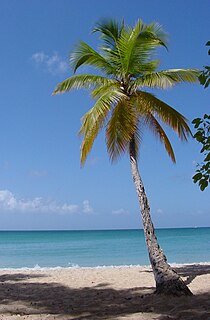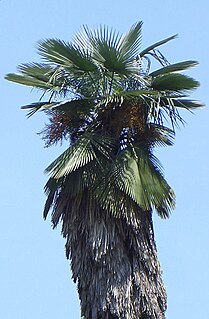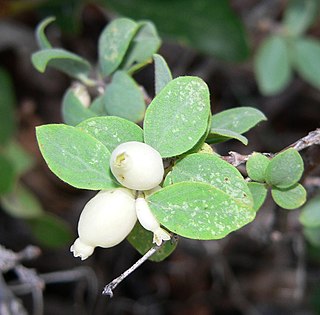
The Arecaceae is a family of perennial flowering plants in the monocot order Arecales. Their growth form can be climbers, shrubs, tree-like and stemless plants, all commonly known as palms. Those having a tree-like form are called palm trees. Currently 181 genera with around 2,600 species are known, most of them restricted to tropical and subtropical climates. Most palms are distinguished by their large, compound, evergreen leaves, known as fronds, arranged at the top of an unbranched stem. However, palms exhibit an enormous diversity in physical characteristics and inhabit nearly every type of habitat within their range, from rainforests to deserts.

Northeast India is the easternmost region of India representing both a geographic and political administrative division of the country. It comprises eight states – Arunachal Pradesh, Assam, Manipur, Meghalaya, Mizoram, Nagaland, Tripura and Sikkim. The region shares an international border of 5,182 kilometres (3,220 mi) with several neighbouring countries – 1,395 kilometres (867 mi) with Tibet Autonomous Region, China in the north, 1,640 kilometres (1,020 mi) with Myanmar in the east, 1,596 kilometres (992 mi) with Bangladesh in the south-west, 97 kilometres (60 mi) with Nepal in the west, and 455 kilometres (283 mi) with Bhutan in the north-west. It comprises an area of 262,230 square kilometres (101,250 sq mi), almost 8 percent of that of India.

Eld's deer, also known as the thamin or brow-antlered deer, is an endangered species of deer endemic to South Asia.

Trachycarpus is a genus of eleven species of palms native to Asia, from the Himalaya east to eastern China. They are fan palms, with the leaves with a bare petiole terminating in a rounded fan of numerous leaflets. The leaf bases produce persistent fibres that often give the trunk a characteristic hairy appearance. All species are dioecious, with male and female flowers produced on separate plants although female plants will sometimes produce male flowers, allowing occasional self-pollination.

Trachycarpus fortunei, the Chinese windmill palm, windmill palm or Chusan palm, is a species of hardy evergreen palm tree in the family Arecaceae, native to parts of China, Japan, Myanmar and India.

Livistona is a genus of palms, the botanical family Arecaceae, native to southeastern and eastern Asia, Australasia, and the Horn of Africa. They are fan palms, the leaves with an armed petiole terminating in a rounded, costapalmate fan of numerous leaflets.

Chamaerops is a genus of flowering plants in the family Arecaceae. The only currently fully accepted species is Chamaerops humilis, variously called European fan palm or the Mediterranean dwarf palm. It is one of the most cold-hardy palms and is used in landscaping in temperate climates.

Odoardo Beccari was an Italian naturalist who discovered the titan arum, the plant with the largest unbranched inflorescence in the world, in Sumatra in 1878. This botanist is denoted by the author abbreviation Becc. when citing a botanical name.

Fan palm as a descriptive term can refer to any of several different kinds of palms (Arecaceae) in various genera with leaves that are palmately lobed. Most are members of the subfamily Coryphoideae, though a few genera in subfamily Calamoideae also have palmate leaves. Fan palm genera include:

Trachycarpus takil, the Kumaon palm, is a fan palm tree that is endemic to the foothills of the Himalaya in southern Asia.

The palm weevil Rhynchophorus ferrugineus is one of two species of snout beetle known as the red palm weevil, Asian palm weevil or sago palm weevil. The adult beetles are relatively large, ranging between 2 and 4 centimetres long, and are usually a rusty red colour—but many colour variants exist and have often been classified as different species. Weevil larvae can excavate holes in the trunks of palm trees up to 1 metre (3.3 ft) long, thereby weakening and eventually killing the host plant. As a result, the weevil is considered a major pest in palm plantations, including the coconut palm, date palm and oil palm.

The Manipur bush rat, also known as Hume's rat or Hume's hadromys, is a species of rodent in the family Muridae. It is found in northeastern India, and is listed as endangered.
Trachycarpus latisectus is an attractive palm tree with large leathery leaves with exceptionally wide segments and a thick, bare and ringed trunk. Its fan-shaped leaves resemble those of Livistona. It has a bare trunk and its seeds resemble those of T. martianus.

Trachycarpus martianus is a species in the genus Trachycarpus from two distinct populations, one at 1,500 m (4,900 ft) in the Khasia Hills, Meghalaya Province, in northeast India, the other at 2,400 m (7,900 ft) in central northern Nepal. Other populations have been reported in Assam, Sikkim, Burma and southern China. The main identifying characteristics are the regular leaf splits, the coffee bean shaped seeds and the bare, as opposed to fibrous trunk. The new leaf spear and edges of the petioles are covered with a white tomentum.

Trachycarpus princeps is a species of palm endemic to Yunnan in southern central China. It grows on limestone cliffs and ridge tops in monsoonal rain forest in the Salween River valley at elevations of 1,500–1,900 metres (4,900–6,200 ft). The epithet is Latin for "prince" and alludes to "the stately bearing of this palm and the majestic way it looks down from its lofty position on the sheer cliff faces". The species was described in 1995 by Gibbons, Spanner & Chen.

Adenanthos oreophilus, commonly known as woollybush, is a species of tall shrub endemic to southwest Western Australia. It is closely related to the better known A. sericeus, and was only classified as a species distinct from the latter in 1978 by Irish botanist E. Charles Nelson.

Symphoricarpos oreophilus is a North American species of flowering plant in the Caprifoliaceae, or honeysuckle family, known by the common name mountain snowberry. It has a wide distribution in western Canada, the United States, and northwestern Mexico. It is found in mountainous areas such as the Cascades, the Sierra Nevada, the Rockies, and the Sierra Madre Occidental from British Columbia to the Copper Canyon region of Chihuahua, from the coastal states as far inland as the Black Hills, the Oklahoma Panhandle, and trans-Pecos Texas.
Trachycarpus ukhrulensis is a plant species endemic to the Manipur region in Assam, India.

Trachycarpeae is a tribe of palms in subfamily Coryphoideae of the plant family Arecaceae. It has the widest distribution of any tribe in Coryphoideae and is found on all continents, though the greatest concentration of species is in Southeast Asia. Trachycarpeae includes palms from both tropical and subtropical zones; the northernmost naturally-occurring palm is a member of this tribe. Several genera can be found in cultivation in temperate areas, for example species of Trachycarpus, Chamaerops, Rhapidophyllum and Washingtonia.















